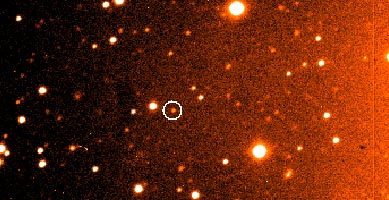
 |
Caliban is a character from Shakespeare's play The Tempest; a savage and deformed slave of the magician Prospero, and is the son of the witch Sycorax who imprisoned the fairy Ariel for disobedience. In The Tempest, Prospero frees Ariel from Sycorax's spell and enslaves Caliban.
Caliban was discovered by Brett Gladman, Phil Nicholson, Joseph Burns, and JJ Kavelaars using the 200 inch Hale telescope; the first images were taken 1997 Sept 6 and 7. Credit for Sycorax goes to Nicholson, Gladman, Burns, and Kavelaars.
 The image above is the discovery image of S/1997 U 1; the one to the right is S/1997 U 2.
The image above is the discovery image of S/1997 U 1; the one to the right is S/1997 U 2.
Prior to this discovery, Uranus was the only one of the gas giants not known to have "irregular" moons, that is, ones whose orbits are not direct and approximately in the plane of the planet's equator.
Like the other irregular moons (eg. Jupiter's outer 8 moons, Phoebe and Nereid), these are probably captured asteroids. It is highly unlikely that they could have been formed initially in these orbits.
The composition of the two moons, according Nicholson, "is probably a plum-pudding mixture of rocks and ice." Both moons are unusually red in color which may suggest a historical link with the Kuiper Belt.
These are the dimmest moons ever to have been imaged with a ground-based telescope.
It's orbit is nearly identical to that of Belinda, about 75,000 km from Uranus. It is about 40 km in diameter.
However, it is not likely that this object is real; see the first link below.
Observations of Uranus taken in Chile in August with the 4-meter Cerro Tololo Interamerican Observatory Blanco telescope have revealed a probable new moon for Uranus. The object is likely 7 to 19 kilometers across and has an orbital semimajor axis of 8.5 million km. Matthew J. Holman (Harvard-Smithsonian Center for Astrophysics) led the trio of observers that made the initial discovery. The finding was announced on the International Astronomical Union Circular 7980.
Many of these recently disovered moons are actually fainter than the ones discovered by Voyager 2.
First imaged by Kavelaars, Gladman, Holman et al with the Canada-France-Hawaii Telescope on Mauna Kea in July 1999.
Their orbits are uncertain at this point but are about 10 and 25 million km from Uranus.
They are probably about 30 or 40 km in diameter (assuming an albedo of .07).